Financial Management: Concept, Importance, Financial Statements, Ratios, and Suggestions for Improvement
VerifiedAdded on 2023/06/18
|13
|2698
|347
AI Summary
This report covers the concept and importance of financial management, financial statements, implementation of financial ratios, and suggestions for improvement. It includes an income statement and balance sheet analysis, and evaluates the profitability, liquidity, and efficiency of the company based on the results of ratio analysis.
Contribute Materials
Your contribution can guide someone’s learning journey. Share your
documents today.

TOP 15376 3005
Secure Best Marks with AI Grader
Need help grading? Try our AI Grader for instant feedback on your assignments.
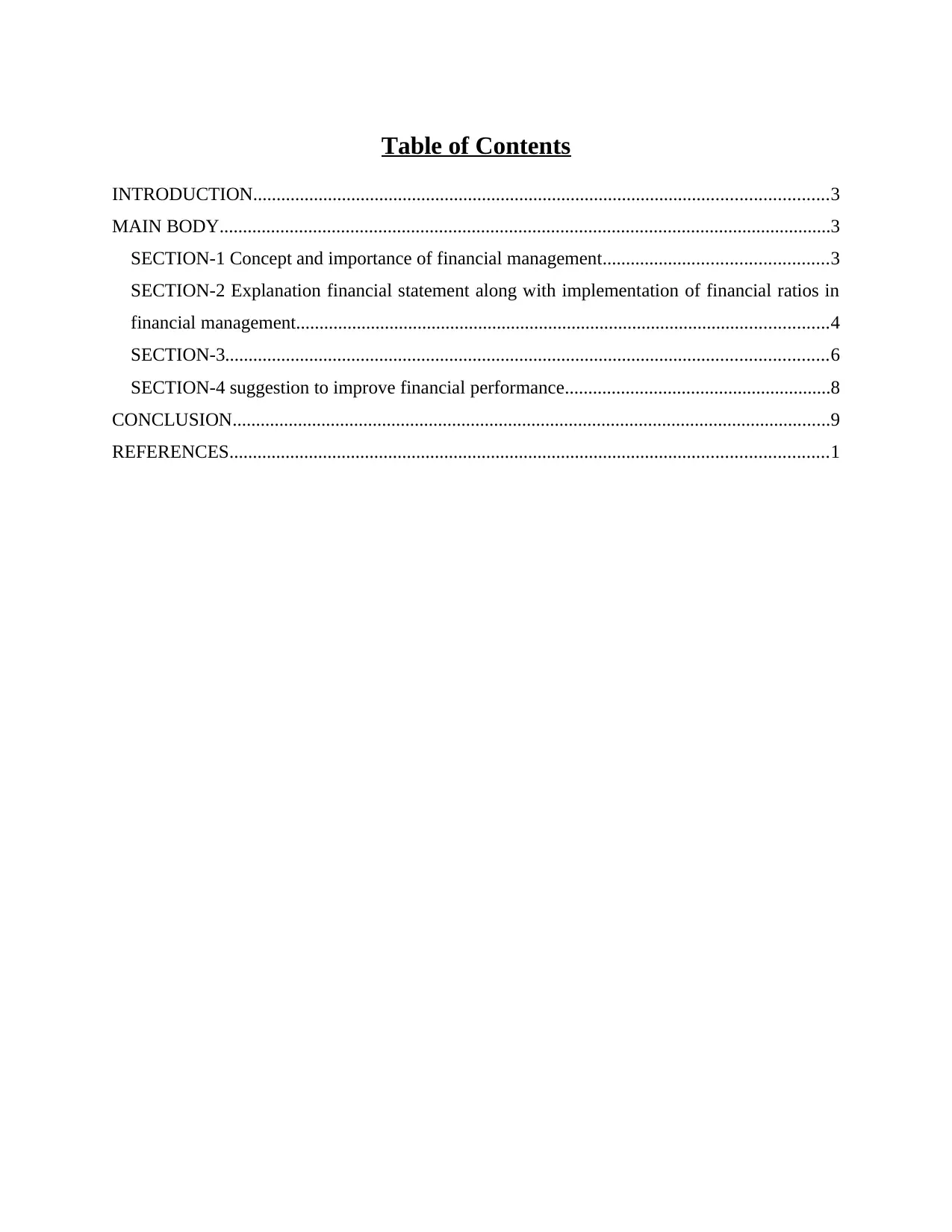
Table of Contents
INTRODUCTION...........................................................................................................................3
MAIN BODY...................................................................................................................................3
SECTION-1 Concept and importance of financial management................................................3
SECTION-2 Explanation financial statement along with implementation of financial ratios in
financial management..................................................................................................................4
SECTION-3.................................................................................................................................6
SECTION-4 suggestion to improve financial performance.........................................................8
CONCLUSION................................................................................................................................9
REFERENCES................................................................................................................................1
INTRODUCTION...........................................................................................................................3
MAIN BODY...................................................................................................................................3
SECTION-1 Concept and importance of financial management................................................3
SECTION-2 Explanation financial statement along with implementation of financial ratios in
financial management..................................................................................................................4
SECTION-3.................................................................................................................................6
SECTION-4 suggestion to improve financial performance.........................................................8
CONCLUSION................................................................................................................................9
REFERENCES................................................................................................................................1
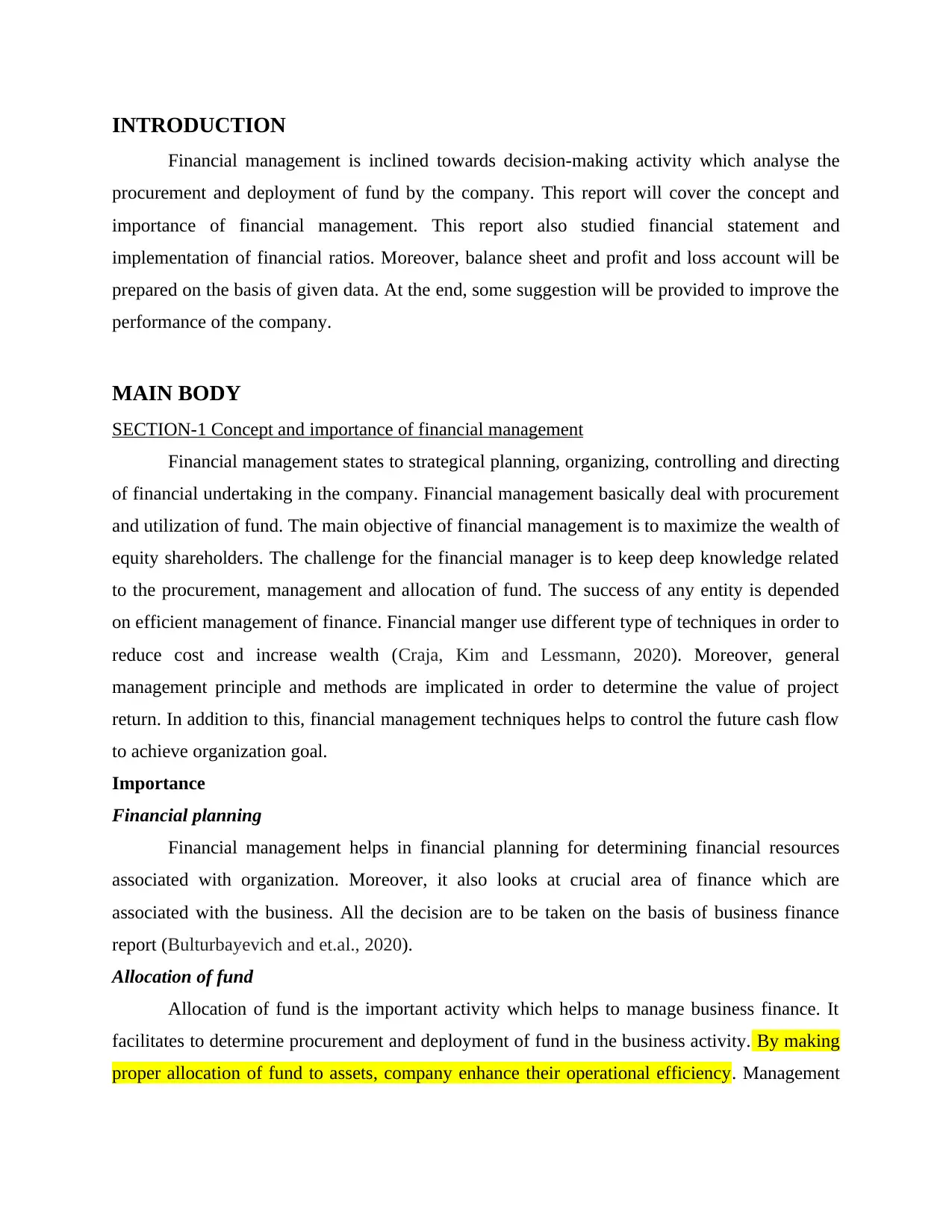
INTRODUCTION
Financial management is inclined towards decision-making activity which analyse the
procurement and deployment of fund by the company. This report will cover the concept and
importance of financial management. This report also studied financial statement and
implementation of financial ratios. Moreover, balance sheet and profit and loss account will be
prepared on the basis of given data. At the end, some suggestion will be provided to improve the
performance of the company.
MAIN BODY
SECTION-1 Concept and importance of financial management
Financial management states to strategical planning, organizing, controlling and directing
of financial undertaking in the company. Financial management basically deal with procurement
and utilization of fund. The main objective of financial management is to maximize the wealth of
equity shareholders. The challenge for the financial manager is to keep deep knowledge related
to the procurement, management and allocation of fund. The success of any entity is depended
on efficient management of finance. Financial manger use different type of techniques in order to
reduce cost and increase wealth (Craja, Kim and Lessmann, 2020). Moreover, general
management principle and methods are implicated in order to determine the value of project
return. In addition to this, financial management techniques helps to control the future cash flow
to achieve organization goal.
Importance
Financial planning
Financial management helps in financial planning for determining financial resources
associated with organization. Moreover, it also looks at crucial area of finance which are
associated with the business. All the decision are to be taken on the basis of business finance
report (Bulturbayevich and et.al., 2020).
Allocation of fund
Allocation of fund is the important activity which helps to manage business finance. It
facilitates to determine procurement and deployment of fund in the business activity. By making
proper allocation of fund to assets, company enhance their operational efficiency. Management
Financial management is inclined towards decision-making activity which analyse the
procurement and deployment of fund by the company. This report will cover the concept and
importance of financial management. This report also studied financial statement and
implementation of financial ratios. Moreover, balance sheet and profit and loss account will be
prepared on the basis of given data. At the end, some suggestion will be provided to improve the
performance of the company.
MAIN BODY
SECTION-1 Concept and importance of financial management
Financial management states to strategical planning, organizing, controlling and directing
of financial undertaking in the company. Financial management basically deal with procurement
and utilization of fund. The main objective of financial management is to maximize the wealth of
equity shareholders. The challenge for the financial manager is to keep deep knowledge related
to the procurement, management and allocation of fund. The success of any entity is depended
on efficient management of finance. Financial manger use different type of techniques in order to
reduce cost and increase wealth (Craja, Kim and Lessmann, 2020). Moreover, general
management principle and methods are implicated in order to determine the value of project
return. In addition to this, financial management techniques helps to control the future cash flow
to achieve organization goal.
Importance
Financial planning
Financial management helps in financial planning for determining financial resources
associated with organization. Moreover, it also looks at crucial area of finance which are
associated with the business. All the decision are to be taken on the basis of business finance
report (Bulturbayevich and et.al., 2020).
Allocation of fund
Allocation of fund is the important activity which helps to manage business finance. It
facilitates to determine procurement and deployment of fund in the business activity. By making
proper allocation of fund to assets, company enhance their operational efficiency. Management
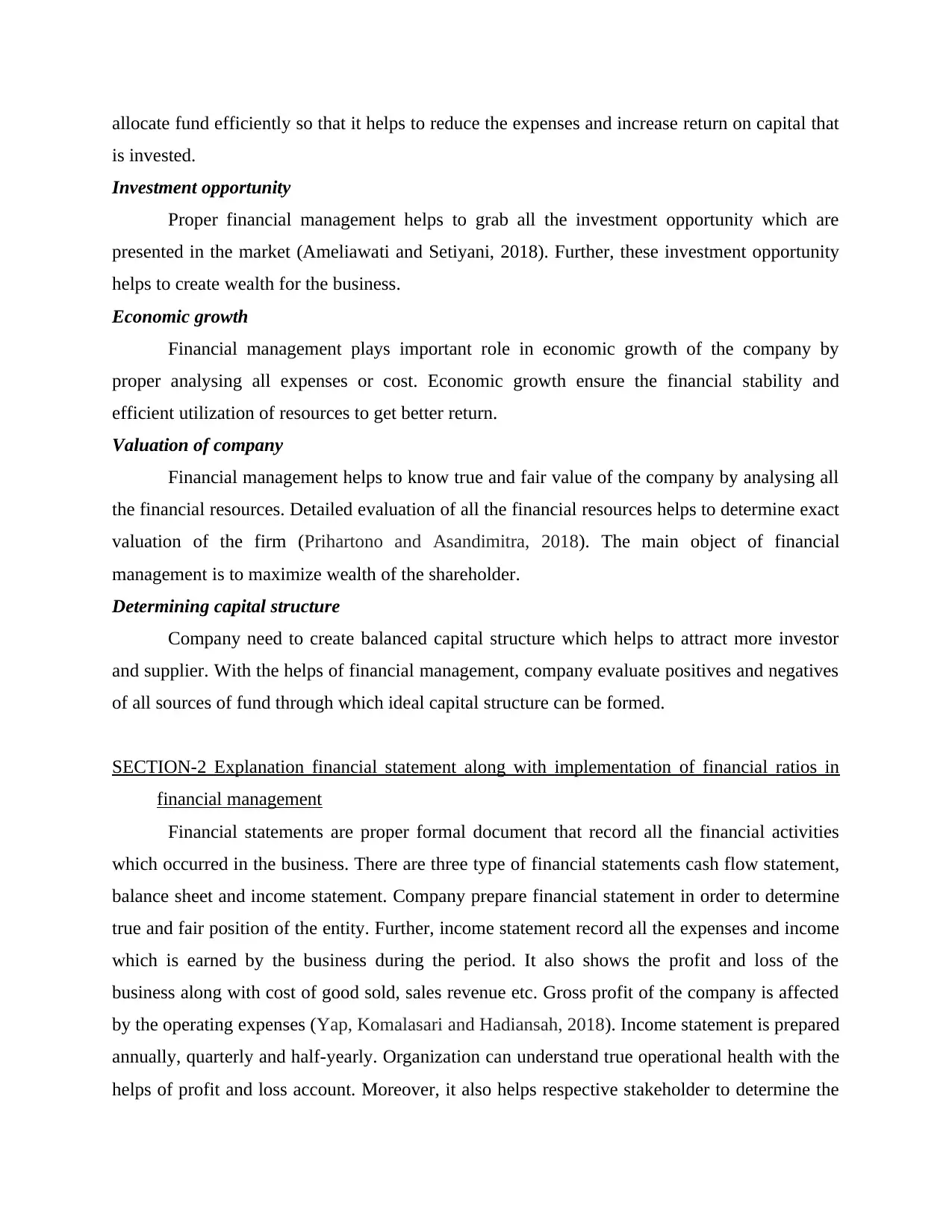
allocate fund efficiently so that it helps to reduce the expenses and increase return on capital that
is invested.
Investment opportunity
Proper financial management helps to grab all the investment opportunity which are
presented in the market (Ameliawati and Setiyani, 2018). Further, these investment opportunity
helps to create wealth for the business.
Economic growth
Financial management plays important role in economic growth of the company by
proper analysing all expenses or cost. Economic growth ensure the financial stability and
efficient utilization of resources to get better return.
Valuation of company
Financial management helps to know true and fair value of the company by analysing all
the financial resources. Detailed evaluation of all the financial resources helps to determine exact
valuation of the firm (Prihartono and Asandimitra, 2018). The main object of financial
management is to maximize wealth of the shareholder.
Determining capital structure
Company need to create balanced capital structure which helps to attract more investor
and supplier. With the helps of financial management, company evaluate positives and negatives
of all sources of fund through which ideal capital structure can be formed.
SECTION-2 Explanation financial statement along with implementation of financial ratios in
financial management
Financial statements are proper formal document that record all the financial activities
which occurred in the business. There are three type of financial statements cash flow statement,
balance sheet and income statement. Company prepare financial statement in order to determine
true and fair position of the entity. Further, income statement record all the expenses and income
which is earned by the business during the period. It also shows the profit and loss of the
business along with cost of good sold, sales revenue etc. Gross profit of the company is affected
by the operating expenses (Yap, Komalasari and Hadiansah, 2018). Income statement is prepared
annually, quarterly and half-yearly. Organization can understand true operational health with the
helps of profit and loss account. Moreover, it also helps respective stakeholder to determine the
is invested.
Investment opportunity
Proper financial management helps to grab all the investment opportunity which are
presented in the market (Ameliawati and Setiyani, 2018). Further, these investment opportunity
helps to create wealth for the business.
Economic growth
Financial management plays important role in economic growth of the company by
proper analysing all expenses or cost. Economic growth ensure the financial stability and
efficient utilization of resources to get better return.
Valuation of company
Financial management helps to know true and fair value of the company by analysing all
the financial resources. Detailed evaluation of all the financial resources helps to determine exact
valuation of the firm (Prihartono and Asandimitra, 2018). The main object of financial
management is to maximize wealth of the shareholder.
Determining capital structure
Company need to create balanced capital structure which helps to attract more investor
and supplier. With the helps of financial management, company evaluate positives and negatives
of all sources of fund through which ideal capital structure can be formed.
SECTION-2 Explanation financial statement along with implementation of financial ratios in
financial management
Financial statements are proper formal document that record all the financial activities
which occurred in the business. There are three type of financial statements cash flow statement,
balance sheet and income statement. Company prepare financial statement in order to determine
true and fair position of the entity. Further, income statement record all the expenses and income
which is earned by the business during the period. It also shows the profit and loss of the
business along with cost of good sold, sales revenue etc. Gross profit of the company is affected
by the operating expenses (Yap, Komalasari and Hadiansah, 2018). Income statement is prepared
annually, quarterly and half-yearly. Organization can understand true operational health with the
helps of profit and loss account. Moreover, it also helps respective stakeholder to determine the
Secure Best Marks with AI Grader
Need help grading? Try our AI Grader for instant feedback on your assignments.
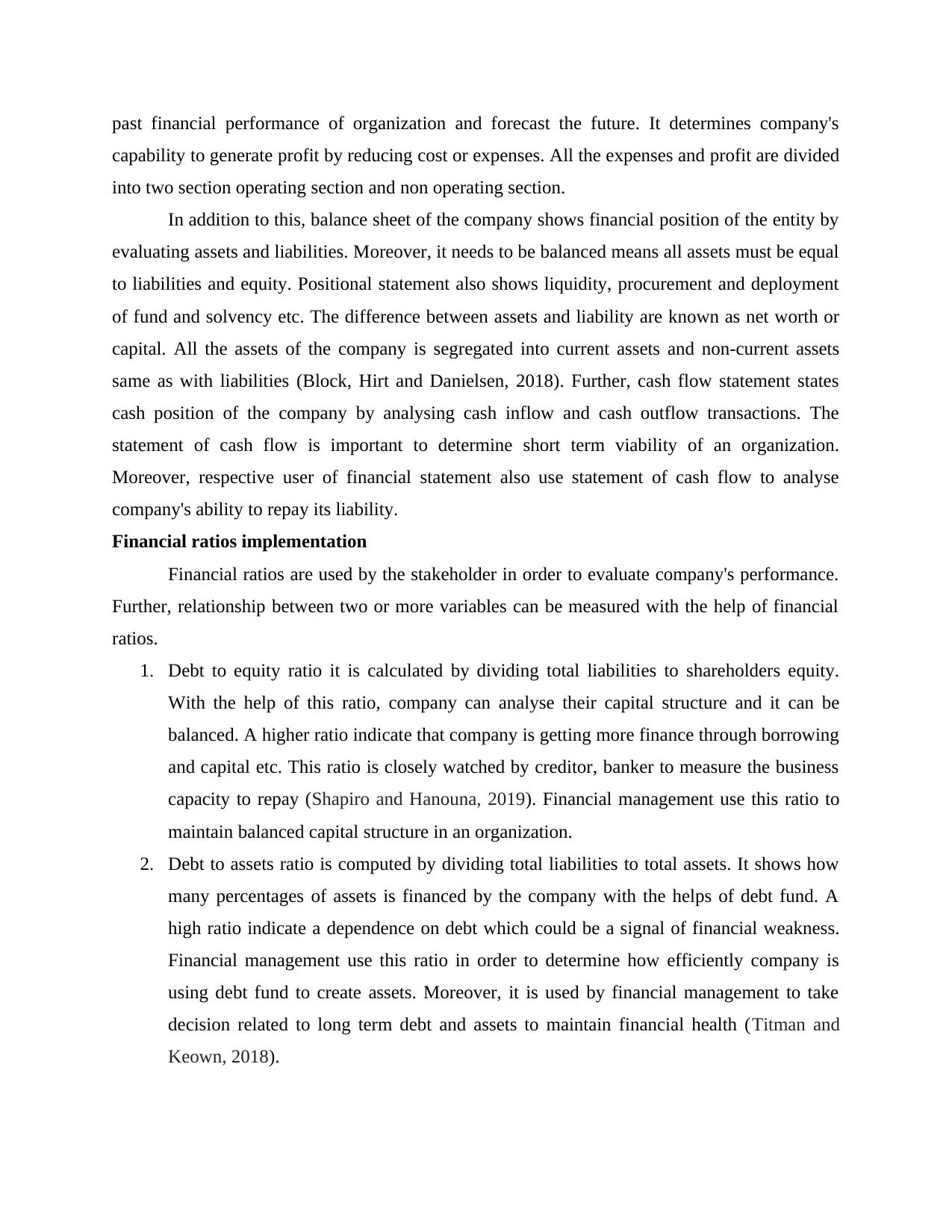
past financial performance of organization and forecast the future. It determines company's
capability to generate profit by reducing cost or expenses. All the expenses and profit are divided
into two section operating section and non operating section.
In addition to this, balance sheet of the company shows financial position of the entity by
evaluating assets and liabilities. Moreover, it needs to be balanced means all assets must be equal
to liabilities and equity. Positional statement also shows liquidity, procurement and deployment
of fund and solvency etc. The difference between assets and liability are known as net worth or
capital. All the assets of the company is segregated into current assets and non-current assets
same as with liabilities (Block, Hirt and Danielsen, 2018). Further, cash flow statement states
cash position of the company by analysing cash inflow and cash outflow transactions. The
statement of cash flow is important to determine short term viability of an organization.
Moreover, respective user of financial statement also use statement of cash flow to analyse
company's ability to repay its liability.
Financial ratios implementation
Financial ratios are used by the stakeholder in order to evaluate company's performance.
Further, relationship between two or more variables can be measured with the help of financial
ratios.
1. Debt to equity ratio it is calculated by dividing total liabilities to shareholders equity.
With the help of this ratio, company can analyse their capital structure and it can be
balanced. A higher ratio indicate that company is getting more finance through borrowing
and capital etc. This ratio is closely watched by creditor, banker to measure the business
capacity to repay (Shapiro and Hanouna, 2019). Financial management use this ratio to
maintain balanced capital structure in an organization.
2. Debt to assets ratio is computed by dividing total liabilities to total assets. It shows how
many percentages of assets is financed by the company with the helps of debt fund. A
high ratio indicate a dependence on debt which could be a signal of financial weakness.
Financial management use this ratio in order to determine how efficiently company is
using debt fund to create assets. Moreover, it is used by financial management to take
decision related to long term debt and assets to maintain financial health (Titman and
Keown, 2018).
capability to generate profit by reducing cost or expenses. All the expenses and profit are divided
into two section operating section and non operating section.
In addition to this, balance sheet of the company shows financial position of the entity by
evaluating assets and liabilities. Moreover, it needs to be balanced means all assets must be equal
to liabilities and equity. Positional statement also shows liquidity, procurement and deployment
of fund and solvency etc. The difference between assets and liability are known as net worth or
capital. All the assets of the company is segregated into current assets and non-current assets
same as with liabilities (Block, Hirt and Danielsen, 2018). Further, cash flow statement states
cash position of the company by analysing cash inflow and cash outflow transactions. The
statement of cash flow is important to determine short term viability of an organization.
Moreover, respective user of financial statement also use statement of cash flow to analyse
company's ability to repay its liability.
Financial ratios implementation
Financial ratios are used by the stakeholder in order to evaluate company's performance.
Further, relationship between two or more variables can be measured with the help of financial
ratios.
1. Debt to equity ratio it is calculated by dividing total liabilities to shareholders equity.
With the help of this ratio, company can analyse their capital structure and it can be
balanced. A higher ratio indicate that company is getting more finance through borrowing
and capital etc. This ratio is closely watched by creditor, banker to measure the business
capacity to repay (Shapiro and Hanouna, 2019). Financial management use this ratio to
maintain balanced capital structure in an organization.
2. Debt to assets ratio is computed by dividing total liabilities to total assets. It shows how
many percentages of assets is financed by the company with the helps of debt fund. A
high ratio indicate a dependence on debt which could be a signal of financial weakness.
Financial management use this ratio in order to determine how efficiently company is
using debt fund to create assets. Moreover, it is used by financial management to take
decision related to long term debt and assets to maintain financial health (Titman and
Keown, 2018).
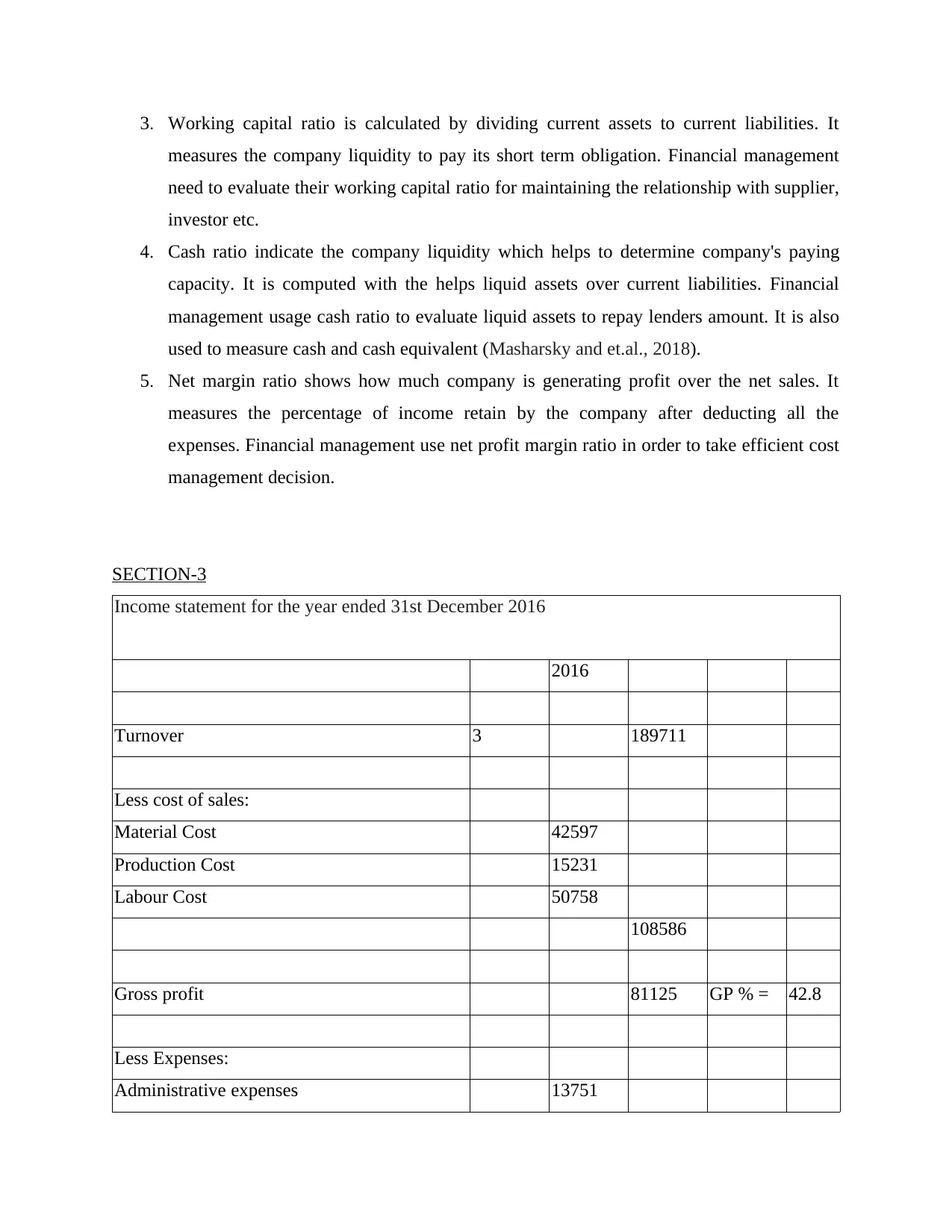
3. Working capital ratio is calculated by dividing current assets to current liabilities. It
measures the company liquidity to pay its short term obligation. Financial management
need to evaluate their working capital ratio for maintaining the relationship with supplier,
investor etc.
4. Cash ratio indicate the company liquidity which helps to determine company's paying
capacity. It is computed with the helps liquid assets over current liabilities. Financial
management usage cash ratio to evaluate liquid assets to repay lenders amount. It is also
used to measure cash and cash equivalent (Masharsky and et.al., 2018).
5. Net margin ratio shows how much company is generating profit over the net sales. It
measures the percentage of income retain by the company after deducting all the
expenses. Financial management use net profit margin ratio in order to take efficient cost
management decision.
SECTION-3
Income statement for the year ended 31st December 2016
2016
Turnover 3 189711
Less cost of sales:
Material Cost 42597
Production Cost 15231
Labour Cost 50758
108586
Gross profit 81125 GP % = 42.8
Less Expenses:
Administrative expenses 13751
measures the company liquidity to pay its short term obligation. Financial management
need to evaluate their working capital ratio for maintaining the relationship with supplier,
investor etc.
4. Cash ratio indicate the company liquidity which helps to determine company's paying
capacity. It is computed with the helps liquid assets over current liabilities. Financial
management usage cash ratio to evaluate liquid assets to repay lenders amount. It is also
used to measure cash and cash equivalent (Masharsky and et.al., 2018).
5. Net margin ratio shows how much company is generating profit over the net sales. It
measures the percentage of income retain by the company after deducting all the
expenses. Financial management use net profit margin ratio in order to take efficient cost
management decision.
SECTION-3
Income statement for the year ended 31st December 2016
2016
Turnover 3 189711
Less cost of sales:
Material Cost 42597
Production Cost 15231
Labour Cost 50758
108586
Gross profit 81125 GP % = 42.8
Less Expenses:
Administrative expenses 13751
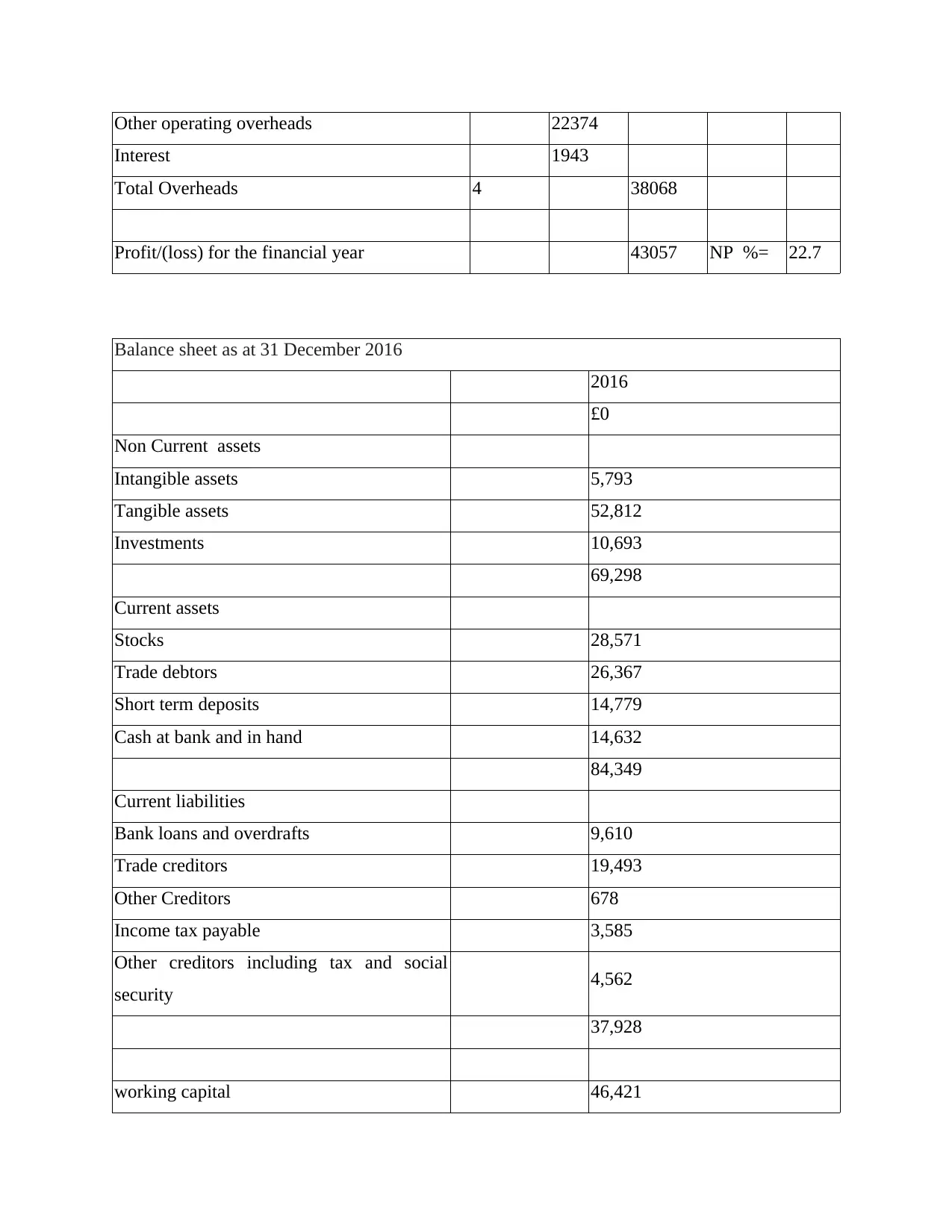
Other operating overheads 22374
Interest 1943
Total Overheads 4 38068
Profit/(loss) for the financial year 43057 NP %= 22.7
Balance sheet as at 31 December 2016
2016
£0
Non Current assets
Intangible assets 5,793
Tangible assets 52,812
Investments 10,693
69,298
Current assets
Stocks 28,571
Trade debtors 26,367
Short term deposits 14,779
Cash at bank and in hand 14,632
84,349
Current liabilities
Bank loans and overdrafts 9,610
Trade creditors 19,493
Other Creditors 678
Income tax payable 3,585
Other creditors including tax and social
security 4,562
37,928
working capital 46,421
Interest 1943
Total Overheads 4 38068
Profit/(loss) for the financial year 43057 NP %= 22.7
Balance sheet as at 31 December 2016
2016
£0
Non Current assets
Intangible assets 5,793
Tangible assets 52,812
Investments 10,693
69,298
Current assets
Stocks 28,571
Trade debtors 26,367
Short term deposits 14,779
Cash at bank and in hand 14,632
84,349
Current liabilities
Bank loans and overdrafts 9,610
Trade creditors 19,493
Other Creditors 678
Income tax payable 3,585
Other creditors including tax and social
security 4,562
37,928
working capital 46,421
Paraphrase This Document
Need a fresh take? Get an instant paraphrase of this document with our AI Paraphraser
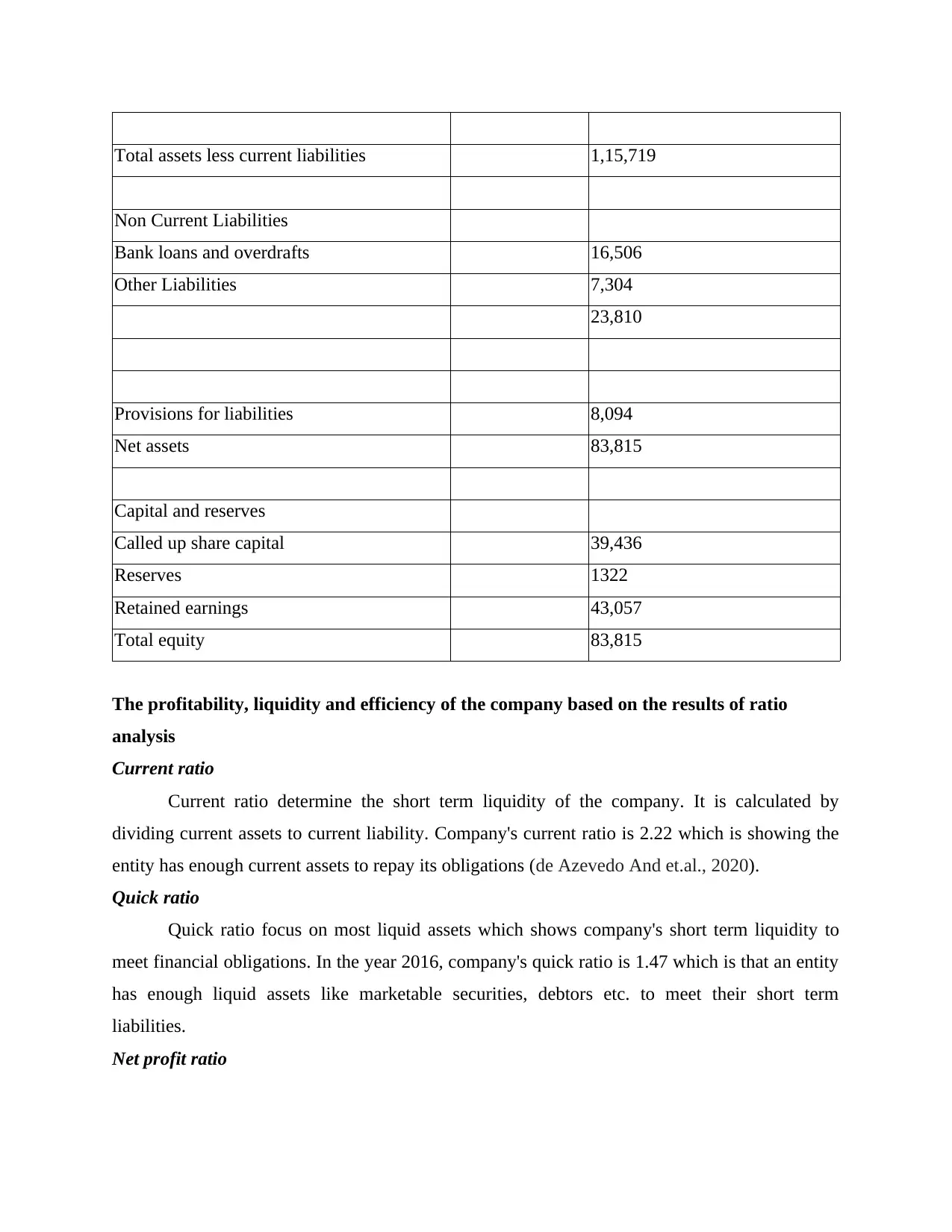
Total assets less current liabilities 1,15,719
Non Current Liabilities
Bank loans and overdrafts 16,506
Other Liabilities 7,304
23,810
Provisions for liabilities 8,094
Net assets 83,815
Capital and reserves
Called up share capital 39,436
Reserves 1322
Retained earnings 43,057
Total equity 83,815
The profitability, liquidity and efficiency of the company based on the results of ratio
analysis
Current ratio
Current ratio determine the short term liquidity of the company. It is calculated by
dividing current assets to current liability. Company's current ratio is 2.22 which is showing the
entity has enough current assets to repay its obligations (de Azevedo And et.al., 2020).
Quick ratio
Quick ratio focus on most liquid assets which shows company's short term liquidity to
meet financial obligations. In the year 2016, company's quick ratio is 1.47 which is that an entity
has enough liquid assets like marketable securities, debtors etc. to meet their short term
liabilities.
Net profit ratio
Non Current Liabilities
Bank loans and overdrafts 16,506
Other Liabilities 7,304
23,810
Provisions for liabilities 8,094
Net assets 83,815
Capital and reserves
Called up share capital 39,436
Reserves 1322
Retained earnings 43,057
Total equity 83,815
The profitability, liquidity and efficiency of the company based on the results of ratio
analysis
Current ratio
Current ratio determine the short term liquidity of the company. It is calculated by
dividing current assets to current liability. Company's current ratio is 2.22 which is showing the
entity has enough current assets to repay its obligations (de Azevedo And et.al., 2020).
Quick ratio
Quick ratio focus on most liquid assets which shows company's short term liquidity to
meet financial obligations. In the year 2016, company's quick ratio is 1.47 which is that an entity
has enough liquid assets like marketable securities, debtors etc. to meet their short term
liabilities.
Net profit ratio
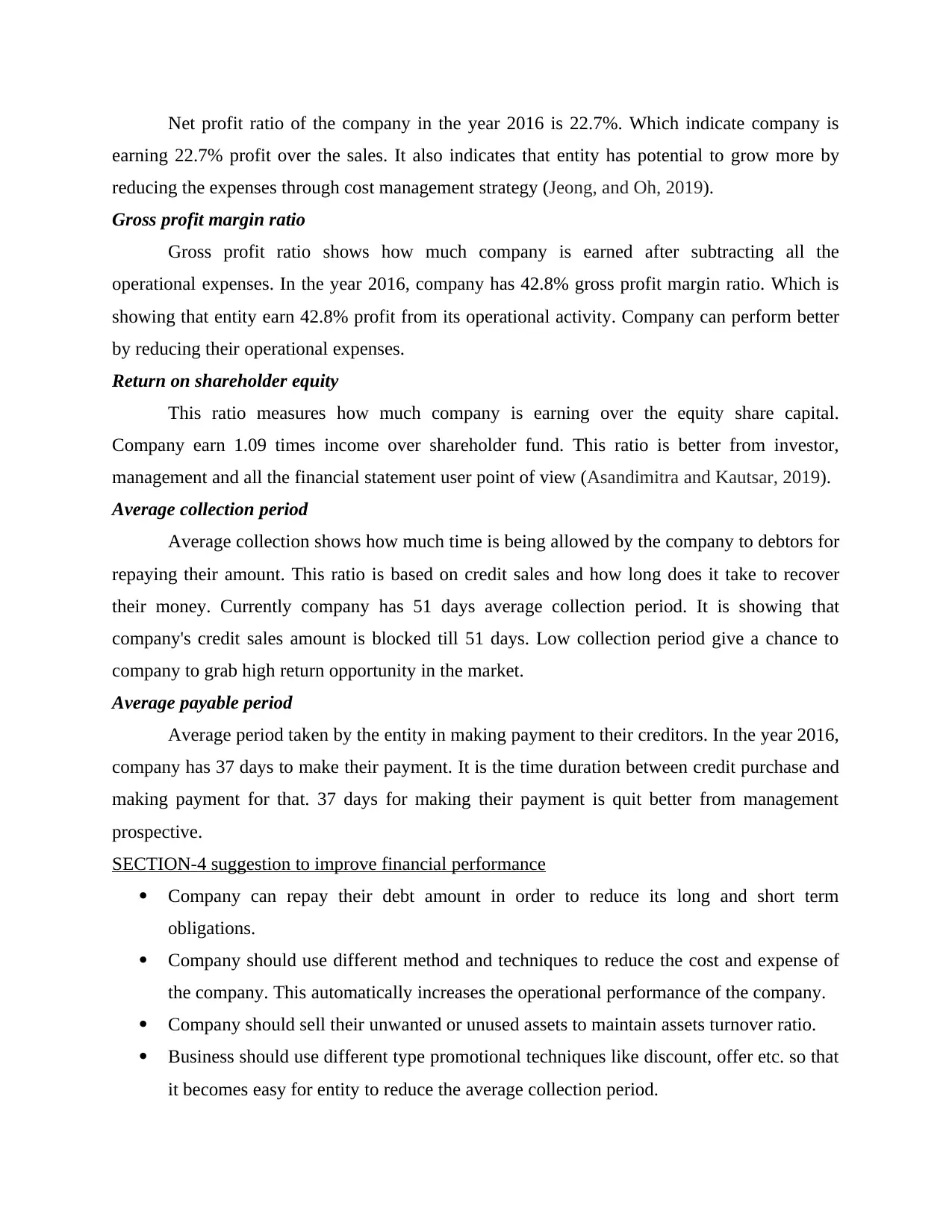
Net profit ratio of the company in the year 2016 is 22.7%. Which indicate company is
earning 22.7% profit over the sales. It also indicates that entity has potential to grow more by
reducing the expenses through cost management strategy (Jeong, and Oh, 2019).
Gross profit margin ratio
Gross profit ratio shows how much company is earned after subtracting all the
operational expenses. In the year 2016, company has 42.8% gross profit margin ratio. Which is
showing that entity earn 42.8% profit from its operational activity. Company can perform better
by reducing their operational expenses.
Return on shareholder equity
This ratio measures how much company is earning over the equity share capital.
Company earn 1.09 times income over shareholder fund. This ratio is better from investor,
management and all the financial statement user point of view (Asandimitra and Kautsar, 2019).
Average collection period
Average collection shows how much time is being allowed by the company to debtors for
repaying their amount. This ratio is based on credit sales and how long does it take to recover
their money. Currently company has 51 days average collection period. It is showing that
company's credit sales amount is blocked till 51 days. Low collection period give a chance to
company to grab high return opportunity in the market.
Average payable period
Average period taken by the entity in making payment to their creditors. In the year 2016,
company has 37 days to make their payment. It is the time duration between credit purchase and
making payment for that. 37 days for making their payment is quit better from management
prospective.
SECTION-4 suggestion to improve financial performance
Company can repay their debt amount in order to reduce its long and short term
obligations.
Company should use different method and techniques to reduce the cost and expense of
the company. This automatically increases the operational performance of the company.
Company should sell their unwanted or unused assets to maintain assets turnover ratio.
Business should use different type promotional techniques like discount, offer etc. so that
it becomes easy for entity to reduce the average collection period.
earning 22.7% profit over the sales. It also indicates that entity has potential to grow more by
reducing the expenses through cost management strategy (Jeong, and Oh, 2019).
Gross profit margin ratio
Gross profit ratio shows how much company is earned after subtracting all the
operational expenses. In the year 2016, company has 42.8% gross profit margin ratio. Which is
showing that entity earn 42.8% profit from its operational activity. Company can perform better
by reducing their operational expenses.
Return on shareholder equity
This ratio measures how much company is earning over the equity share capital.
Company earn 1.09 times income over shareholder fund. This ratio is better from investor,
management and all the financial statement user point of view (Asandimitra and Kautsar, 2019).
Average collection period
Average collection shows how much time is being allowed by the company to debtors for
repaying their amount. This ratio is based on credit sales and how long does it take to recover
their money. Currently company has 51 days average collection period. It is showing that
company's credit sales amount is blocked till 51 days. Low collection period give a chance to
company to grab high return opportunity in the market.
Average payable period
Average period taken by the entity in making payment to their creditors. In the year 2016,
company has 37 days to make their payment. It is the time duration between credit purchase and
making payment for that. 37 days for making their payment is quit better from management
prospective.
SECTION-4 suggestion to improve financial performance
Company can repay their debt amount in order to reduce its long and short term
obligations.
Company should use different method and techniques to reduce the cost and expense of
the company. This automatically increases the operational performance of the company.
Company should sell their unwanted or unused assets to maintain assets turnover ratio.
Business should use different type promotional techniques like discount, offer etc. so that
it becomes easy for entity to reduce the average collection period.
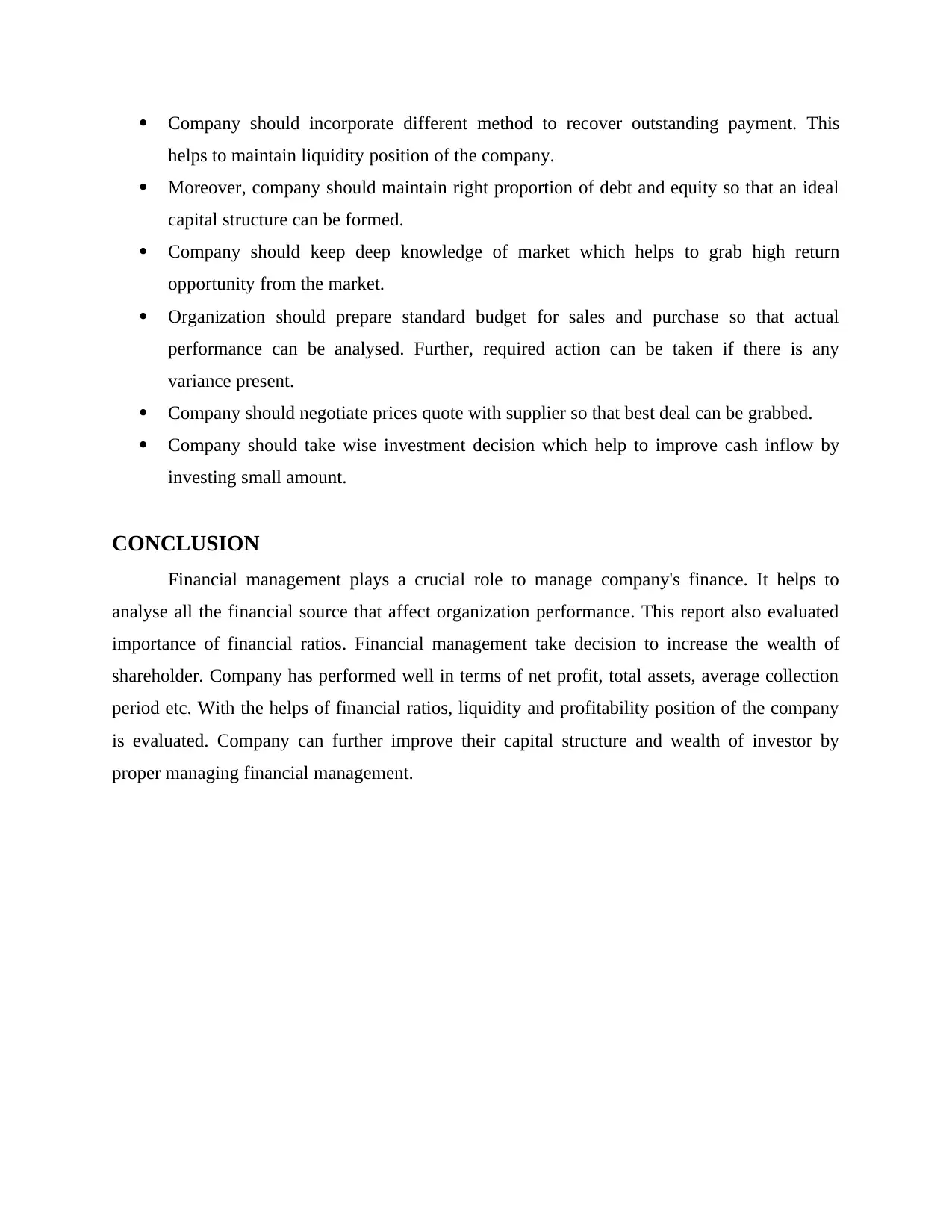
Company should incorporate different method to recover outstanding payment. This
helps to maintain liquidity position of the company.
Moreover, company should maintain right proportion of debt and equity so that an ideal
capital structure can be formed.
Company should keep deep knowledge of market which helps to grab high return
opportunity from the market.
Organization should prepare standard budget for sales and purchase so that actual
performance can be analysed. Further, required action can be taken if there is any
variance present.
Company should negotiate prices quote with supplier so that best deal can be grabbed.
Company should take wise investment decision which help to improve cash inflow by
investing small amount.
CONCLUSION
Financial management plays a crucial role to manage company's finance. It helps to
analyse all the financial source that affect organization performance. This report also evaluated
importance of financial ratios. Financial management take decision to increase the wealth of
shareholder. Company has performed well in terms of net profit, total assets, average collection
period etc. With the helps of financial ratios, liquidity and profitability position of the company
is evaluated. Company can further improve their capital structure and wealth of investor by
proper managing financial management.
helps to maintain liquidity position of the company.
Moreover, company should maintain right proportion of debt and equity so that an ideal
capital structure can be formed.
Company should keep deep knowledge of market which helps to grab high return
opportunity from the market.
Organization should prepare standard budget for sales and purchase so that actual
performance can be analysed. Further, required action can be taken if there is any
variance present.
Company should negotiate prices quote with supplier so that best deal can be grabbed.
Company should take wise investment decision which help to improve cash inflow by
investing small amount.
CONCLUSION
Financial management plays a crucial role to manage company's finance. It helps to
analyse all the financial source that affect organization performance. This report also evaluated
importance of financial ratios. Financial management take decision to increase the wealth of
shareholder. Company has performed well in terms of net profit, total assets, average collection
period etc. With the helps of financial ratios, liquidity and profitability position of the company
is evaluated. Company can further improve their capital structure and wealth of investor by
proper managing financial management.
Secure Best Marks with AI Grader
Need help grading? Try our AI Grader for instant feedback on your assignments.
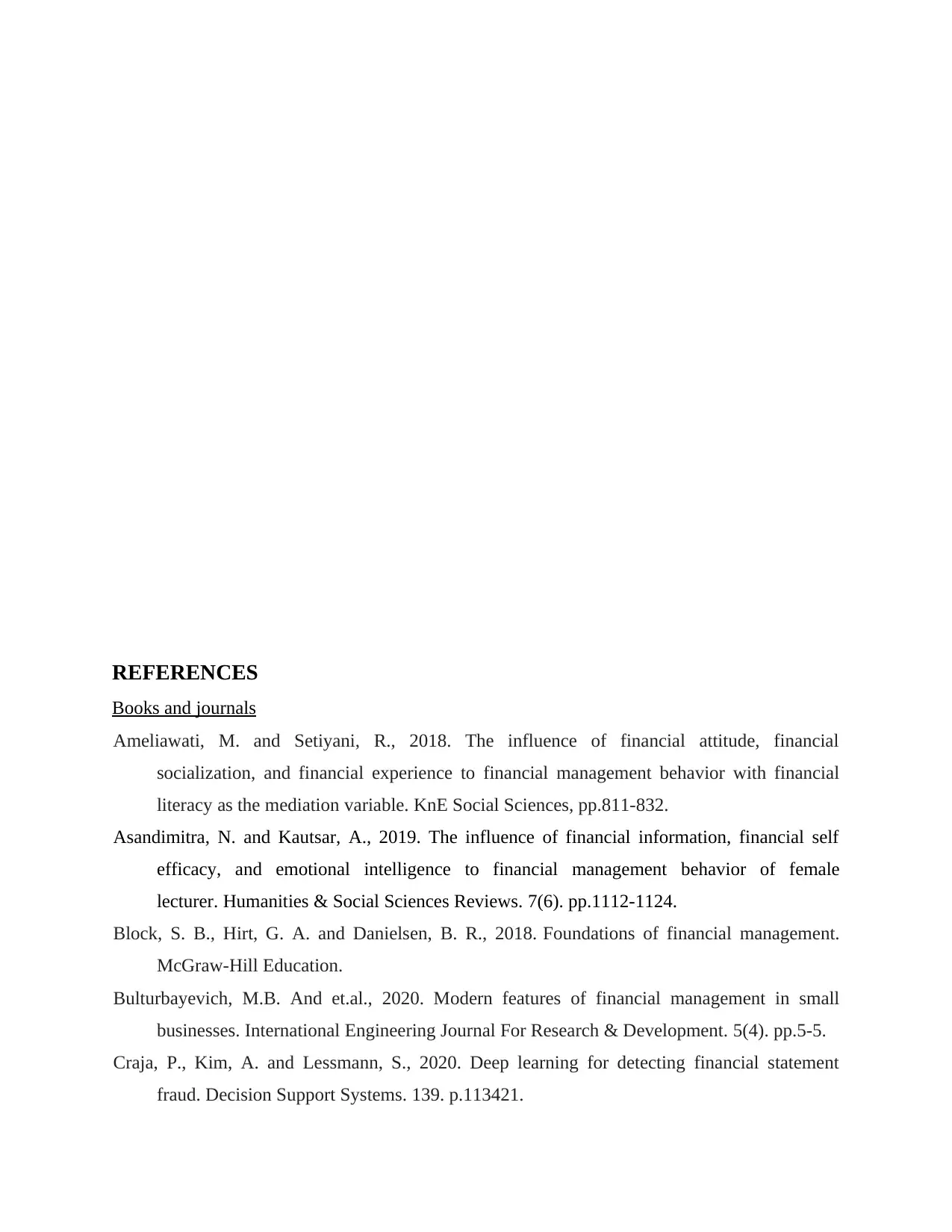
REFERENCES
Books and journals
Ameliawati, M. and Setiyani, R., 2018. The influence of financial attitude, financial
socialization, and financial experience to financial management behavior with financial
literacy as the mediation variable. KnE Social Sciences, pp.811-832.
Asandimitra, N. and Kautsar, A., 2019. The influence of financial information, financial self
efficacy, and emotional intelligence to financial management behavior of female
lecturer. Humanities & Social Sciences Reviews. 7(6). pp.1112-1124.
Block, S. B., Hirt, G. A. and Danielsen, B. R., 2018. Foundations of financial management.
McGraw-Hill Education.
Bulturbayevich, M.B. And et.al., 2020. Modern features of financial management in small
businesses. International Engineering Journal For Research & Development. 5(4). pp.5-5.
Craja, P., Kim, A. and Lessmann, S., 2020. Deep learning for detecting financial statement
fraud. Decision Support Systems. 139. p.113421.
Books and journals
Ameliawati, M. and Setiyani, R., 2018. The influence of financial attitude, financial
socialization, and financial experience to financial management behavior with financial
literacy as the mediation variable. KnE Social Sciences, pp.811-832.
Asandimitra, N. and Kautsar, A., 2019. The influence of financial information, financial self
efficacy, and emotional intelligence to financial management behavior of female
lecturer. Humanities & Social Sciences Reviews. 7(6). pp.1112-1124.
Block, S. B., Hirt, G. A. and Danielsen, B. R., 2018. Foundations of financial management.
McGraw-Hill Education.
Bulturbayevich, M.B. And et.al., 2020. Modern features of financial management in small
businesses. International Engineering Journal For Research & Development. 5(4). pp.5-5.
Craja, P., Kim, A. and Lessmann, S., 2020. Deep learning for detecting financial statement
fraud. Decision Support Systems. 139. p.113421.
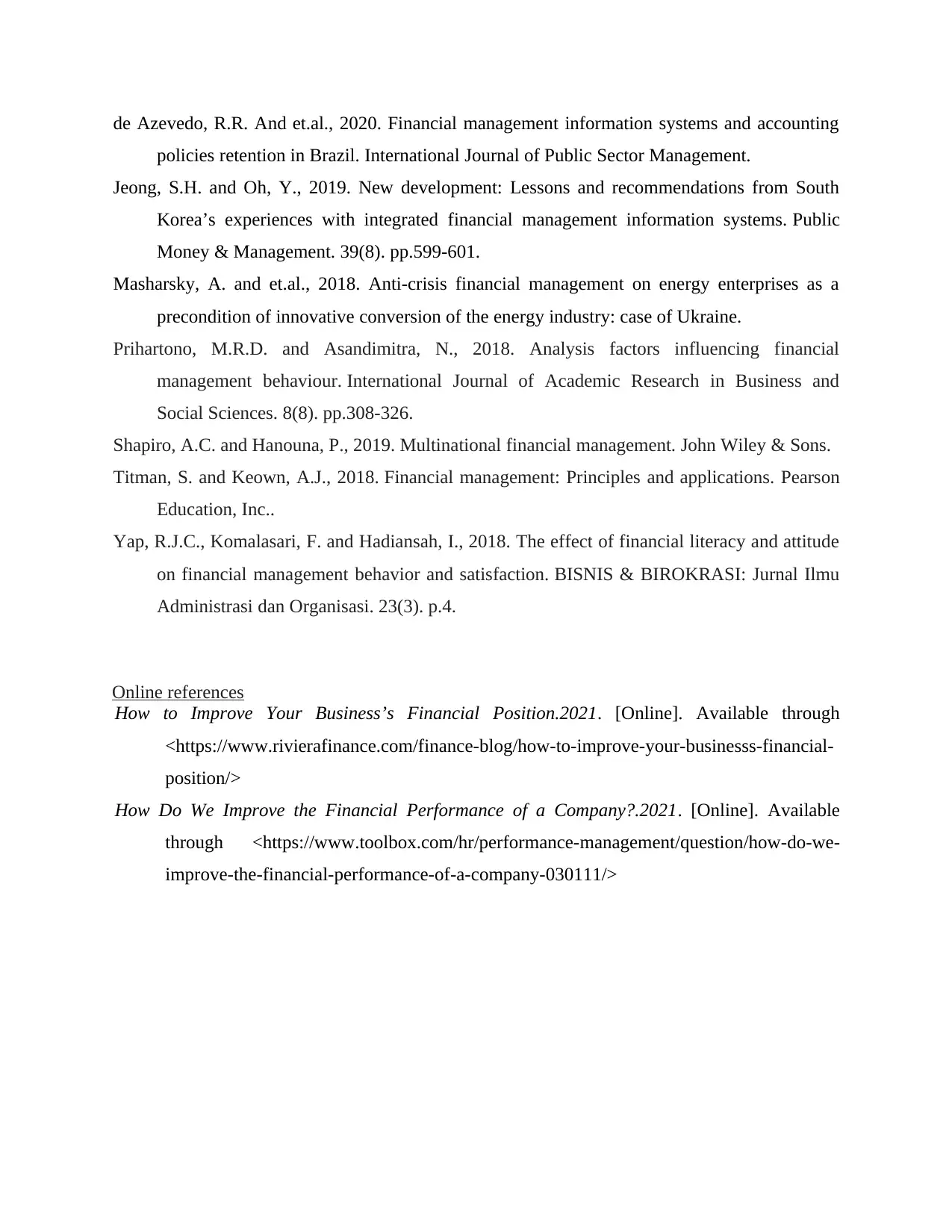
de Azevedo, R.R. And et.al., 2020. Financial management information systems and accounting
policies retention in Brazil. International Journal of Public Sector Management.
Jeong, S.H. and Oh, Y., 2019. New development: Lessons and recommendations from South
Korea’s experiences with integrated financial management information systems. Public
Money & Management. 39(8). pp.599-601.
Masharsky, A. and et.al., 2018. Anti-crisis financial management on energy enterprises as a
precondition of innovative conversion of the energy industry: case of Ukraine.
Prihartono, M.R.D. and Asandimitra, N., 2018. Analysis factors influencing financial
management behaviour. International Journal of Academic Research in Business and
Social Sciences. 8(8). pp.308-326.
Shapiro, A.C. and Hanouna, P., 2019. Multinational financial management. John Wiley & Sons.
Titman, S. and Keown, A.J., 2018. Financial management: Principles and applications. Pearson
Education, Inc..
Yap, R.J.C., Komalasari, F. and Hadiansah, I., 2018. The effect of financial literacy and attitude
on financial management behavior and satisfaction. BISNIS & BIROKRASI: Jurnal Ilmu
Administrasi dan Organisasi. 23(3). p.4.
Online references
How to Improve Your Business’s Financial Position.2021. [Online]. Available through
<https://www.rivierafinance.com/finance-blog/how-to-improve-your-businesss-financial-
position/>
How Do We Improve the Financial Performance of a Company?.2021. [Online]. Available
through <https://www.toolbox.com/hr/performance-management/question/how-do-we-
improve-the-financial-performance-of-a-company-030111/>
policies retention in Brazil. International Journal of Public Sector Management.
Jeong, S.H. and Oh, Y., 2019. New development: Lessons and recommendations from South
Korea’s experiences with integrated financial management information systems. Public
Money & Management. 39(8). pp.599-601.
Masharsky, A. and et.al., 2018. Anti-crisis financial management on energy enterprises as a
precondition of innovative conversion of the energy industry: case of Ukraine.
Prihartono, M.R.D. and Asandimitra, N., 2018. Analysis factors influencing financial
management behaviour. International Journal of Academic Research in Business and
Social Sciences. 8(8). pp.308-326.
Shapiro, A.C. and Hanouna, P., 2019. Multinational financial management. John Wiley & Sons.
Titman, S. and Keown, A.J., 2018. Financial management: Principles and applications. Pearson
Education, Inc..
Yap, R.J.C., Komalasari, F. and Hadiansah, I., 2018. The effect of financial literacy and attitude
on financial management behavior and satisfaction. BISNIS & BIROKRASI: Jurnal Ilmu
Administrasi dan Organisasi. 23(3). p.4.
Online references
How to Improve Your Business’s Financial Position.2021. [Online]. Available through
<https://www.rivierafinance.com/finance-blog/how-to-improve-your-businesss-financial-
position/>
How Do We Improve the Financial Performance of a Company?.2021. [Online]. Available
through <https://www.toolbox.com/hr/performance-management/question/how-do-we-
improve-the-financial-performance-of-a-company-030111/>

1 out of 13
Related Documents
Your All-in-One AI-Powered Toolkit for Academic Success.
+13062052269
info@desklib.com
Available 24*7 on WhatsApp / Email
![[object Object]](/_next/static/media/star-bottom.7253800d.svg)
Unlock your academic potential
© 2024 | Zucol Services PVT LTD | All rights reserved.


